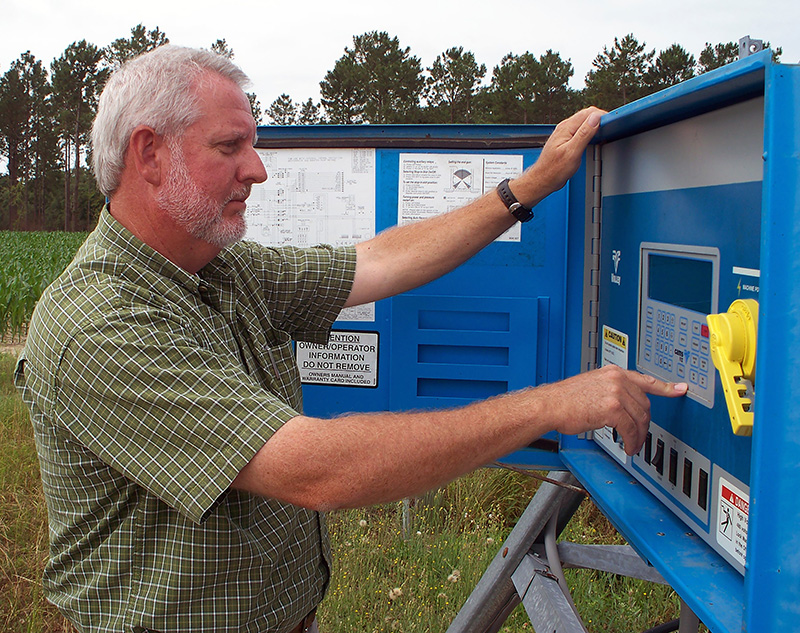Precipitation across Georgia for the month of August 2015 varied widely, from more than 10 inches near the coast and in north-central Georgia to less than 2 inches in the southwest corner of the state. A few isolated areas received more than 15 inches during the month, according to Community Collaborative Rain, Hail and Snow Network (CoCoRaHS) observers.
Three daily rainfall records were set in August. Columbus, Georgia, received 3.8 inches on Aug. 6, breaking that city’s old record of 1.65 inches set in 1966. Brunswick, Georgia, received 4.07 inches on Aug. 31, breaking that city’s old record of 1.36 inches set in 1991. Alma, Georgia, received 4.65 inches on Aug. 28, breaking that city’s old record of 1.64 inches set in 1954.
The highest single-day rainfall was 5.22 inches, recorded by CoCoRaHS stations west of Valdosta, Georgia, in Lowndes County on Aug. 31, followed by 5.04 inches recorded west of Bethlehem, Georgia, in Gwinnett County on Aug. 23. The highest monthly total rainfall was 18.55 inches, observed east of Savannah, Georgia, in Chatham County. Another nearby observer reported 16.06 inches in August.
Severe weather was observed on 15 out of 31 days last month. Almost all of these incidences brought on scattered wind damage. A microburst caused significant tree damage to the Rock Eagle 4-H Center facility near Eatonton, Georgia, on Aug. 6, a date that also saw widespread wind damage in other parts of the state.
The highest monthly total precipitation, according to National Weather Service reporting stations, was recorded at 7.84 inches in Savannah — 1.28 inches above normal — and the lowest monthly total precipitation was recorded in in Augusta, Georgia, at 3.74 inches — 0.58 inches below normal. Atlanta received 5.77 inches of total precipitation, 1.87 inches above normal; Athens, Georgia, received 6.78 inches, 3.25 inches above normal; Columbus received 7.50 inches, 3.73 inches above normal; Macon, Georgia, received 5.07 inches, 0.97-inch above normal; Alma received 4.65 inches, 0.76-inch below normal; Brunswick received 6.76 inches, 0.46-inch above normal; Albany, Georgia, received 5.42 inches, 0.58-inch above normal; Rome, Georgia, received 4.38 inches, 0.25-inch above normal; and Valdosta received 6.39 inches, 1.05 inches above normal.
Coastal areas of Georgia as well as areas to the east of Atlanta were the wettest parts of the state, and the driest area was in southwest Georgia, near Thomasville.
Agriculture Impacts
Crops generally did well statewide in August, although dry conditions caused some stress and increased pest pressure.
The U.S. Drought Monitor shows that drought increased across Georgia again in August. Drought conditions across large parts of the state are expected to increase for the next three months. However, if El Niño conditions come early this winter, wet conditions could reduce dryness drastically. These wet conditions could occur early this year due to the strength of the El Niño, so farmers should harvest in a timely manner, especially on fields that are prone to flooding. September temperatures are expected to be above normal across the state and may aid in maturing crops. The expected dry conditions could hamper efforts to plant wheat, cool season vegetables and fescue.
Temperature
Temperatures were very close to normal across the state, and the coolest areas were, generally, also the wettest.
In Atlanta, the monthly average temperature was 79.9 degrees Fahrenheit, 0.5-degree above normal; in Athens, 79.8 F, 0.2-degree above normal; in Columbus, 81.6 F, 0.3-degree below normal; in Macon, 80.6 F, 0.3-degree below normal; in Savannah, 81.8 F, 0.3-degree above normal; in Brunswick, 81.6 F, 0.2-degree below normal; in Alma, 82 F, 0.7-degree above normal; in Augusta, 80.6 F, 0.1-degree above normal; in Albany, 82.8 F, 0.8-degree above normal; in Rome, 78.5 F, 0.2-degree below normal; and in Valdosta, 82.5 F, 1.3 degrees above normal.
No temperature records were broken this month, but a record high minimum temperature of 75 F was tied in Alma on Aug. 12 — the city hit the same high minimum temperature in 2013 — and a record low maximum temperature of 84 F was tied in Brunswick on Aug. 2 — the city hit the same low maximum temperature in 2007. Columbus also tied their record high maximum temperature of 99 F on Aug. 4 — the city hit the same high maximum temperature in 2011.
For more information, see the “Climate and Agriculture in the South East” blog at blog.extension.uga.edu/climate or visit our new Web page at gaclimate.org. Please feel free to email your photos or stories of how Georgia weather and climate impacted agriculture in your area to pknox@uga.edu, so she can share it on the blog.




